

|
| articles | forbidden stories I-State Lines resources my hidden history reviews | home | ||

Writing/Film Dear Aspiring Writers: The Worst Advice You'll Ever Read A Literary Look at I-State Lines Spirited Away: Decay and Renewal An American Poem (Robinson Jeffers) Taoist Chinese Poems The Nelson Touch "It's all about oil, isn't it?" Kurosawa's High and Low A Bountiful Mutiny Howl's Moving Castle Thailand's Iron Ladies Trois Colours: Red The Thin Man: Thoroughly Modern Movies Why My Book Is Better Than the DaVinci Code Iranian Films: The Mirror Piratical Nonsense A Real Pirate Movie: Captain Blood 9 more in archive Recommended Books American Identity American Identity Literary Contest Winners, 2006 (fiction and essays) Hapas: The New America Can You Tell What I am? Part I Can You Tell What I am? Part II Only in America Self-Reliance Your Tattoo in 50 Years The American House and Frank Lloyd Wright Cultural Commentaries On Hatred and Anti-Americanism Anti-Americanism Part 2 Anti-Americanism Part 3 French-Bashing Germany: We All Have Problems, But... Kroika! Chronicles This Blog Sells Out Doom and Gloom Sells The Kroika Mascot-"Auspicious Pet" Wal-Mart and Kroika Kroika and Starsbuck Take a Hit Kroika Ad 1 Kroika Ad 2 Kroika Ad 3 Kroika Ad 4 Kroika Makes Bid for Oreo (April 1) Unfolding Crises: Asia China: An Interim Report Shanghai Postcard 2004 Corruption and Avian Flu: China's Dynamic Duo Exporting the Real Estate Bubble to China Is the Bloom Off the China Rose? China Irony: Steel, Marx & Capital Curing The U.S. and China's Dysfunctional Relationship China and U.S. Inflation Trade with China: Making Out Like a Bandit Whither China? Will the Housing Bust Take Down China? China's Dependence on Exports to U.S.; Is China About to Pop? 8 more Battle for the Soul of America Katrina, Vietnam, Iraq: National Purpose, National Sacrifice Is This a Nation at War? A Nation in Denial Why Is This Such a Tepid Time? That Price Isn't Cheap, It's Subsidized The Most Hated Company in America U.S. Fascists Seek Ban on Cancer Vaccine The Truth About Christmas American Dream or American Nightmare? 2006 Sea Change Obesity and Debt Immigration Ironies U.S. Healthcare: Working Toward a Real Solution A Drug Industry Running Amok Where There Is Ruin 10 more Financial Meltdown Watch What This Country Needs Is a... Good Recession Are We Entering the Next Age of Turmoil? Why Inflation Appears Low Doubling Down on 5-Card No-See-Um A Rickety Global House of Cards Are Japan and Germany Truly on the Mend? Unprecedented Risk 2 Could One Rogue Trader Bring Down the Market? Worried about Inflation? Stop Measuring It Economy Great? Bah, Humbug Huge Deficits and Huge Profits: Coincidence? Who's The Largest Exporter? Three Snapshots of the U.S. Economy Loaded for Bear Comparing Nasdaq to Depression-Era Dow Who's Buying Treasury Bonds? And Why? Derivatives: Wall Street Fiddles, Rome Smolders Financial Chickens Coming Home to Roost Is the Stock Market on the Same Planet as the Economy? The Housing-Recession-Oil-Healthcare Connection Could We Have Deflation and Inflation At the Same Time? What We Know, What We Can Safely Predict Bankruptcy U.S.A.: Medicare, Greed and Collapse Sucker's Rally A Whiff of Apocalypse Where There Is Ruin II: Social Security 31 more Planetary Meltdown Watch The Immensity of Global Warming Sun Sets on Skeptics of Global Warming Housing Bubble Watch Charting Unaffordability A Monster of a Housing Bubble A Coup de Grace to the Economy Hidden Costs of the Housing Bubble Housing Bubble? What Bubble? Housing Bubble II Housing Bubble III: Pop! Housing Market Slips Toward Cliff Housing Market Demographics Housing: Catching the Falling Knife Five Stages of the Housing Bubble Derailing the Property Tax Gravy Train Bubbling Property Taxes Have You Checked Your Property Taxes Recently? Housing Bubble: Where's the Bottom? Housing Bubble: Bottom II The Housing - Inflation Connection The Coming Foreclosure Nightmare 1 How Many Foreclosures Will Hit the Market? Housing Wealth Effect Shifts Into Reverse Housing Bubble Bust Will Take Down the Global Economy The New Road to Serfdom: A Negative-Equity Mortgage The Housing-Savings-Recession Connection After the Bubble: How Low Will It Go? After the Bubble: Rents and Housing Values Why Post-Bubble Rents Matter After the Bubble: How Low Will We Go, Part II Housing: 10% Decline May Trigger Financial Ruin How to Buy a $450K Home for $750K Inflation and Housing: Calculating the Bust The Growing Financial Risks of the Housing Bubble Construction Defects: The Flood to Come? Construction Defects Part II Who Gets Hammered in the 2007 Housing Bust Real Estate Bust: The Exhaustion of Debt What Happens When Housing Employment Plummets? One More Hole in the Housing Bubble: Insurance Financial Kryptonite in a "Super-Strength" Housing Market Three Secrets to Unloading Property Today Welcome to Fantasyland: Housing's "Soft Landing" Why Is the Median House Price Still Rising? Why Median Prices Appear to be Rising? The Root Cause of the Housing Bubble Housing Dominoes Fall Twilight for Exurbia? Phase Transitions, Symmetry and Post-Bubble Declines Housing's Stairstep Descent 10 more Oil/Energy Crises Whither Oil? How much Is a Gallon of Gas Worth? The End of Cheap Oil Natural Gas, Naturally High Arab Oil Money and U.S. Treasuries: Quid Pro Quo? The C.I.A., Oil and the Wisdom of Crowds The Flutter of a Butterfly's Wings? A One-Two Punch to a Glass Jaw Running Out Of Oil vs. Running Out of Cheap Oil 2 more Outside the Box How to Make a Favicon Asian Emoticons In Memoriam: Winky Cosmos The Wheeled Vagabonds Geezer Rock Overload Paying for Web Content Light-As-Air Pancake Recipe In a Humorous Vein If Only Writers Had Uniforms Opening the Kimono Happiness for Sale: Jank Coffee Ten Guaranteed Predictions for 2010 Why My Book Is Better Than the DaVinci Code My Brand Management Stinks Design Follies The New Jank Coffee Shop Jank Coffee, Upscale Tropic Style One-Word Titles Complacency Nostalgia Lifespans Praxis Keys to Affordable Housing U.S. Conservation & China Steve Toma, Me & Skil 77s: 30 years of Labor Real Science in the Bolivian Forest Deforestation and Sustainable Forestry The Solar Economy (book) The Problem with Techno-Fixes I Love Technology, I Hate Technology How To Blow off Web Ads and More 2 more Health, Wealth & Demographics Beauty of the Augmented (Korean) Kind Demographics and War The Healthiest Cold Cereal: Surprise! 900 Miles to the Gallon Are Our Cities Making Us Fat? One Serving of Deception Is Obesity an Inflammatory Response? Demographics & National Bankruptcy The Decline of Europe: A Demographic Done Deal? Are the Risks of Obesity Overstated? Healthcare: Unaffordable Everywhere Medication Nation The New Disease We Just Know You've Got Can You Can Tell Which Pill Is Fake? Bankruptcy U.S.A.: Medicare, Greed and Collapse The 10 Secrets to Permanent Weight Loss 5 more Landscapes Selling the Landscape The Downside of Density Building Heights and Arboral Roots Terroir: France & California L.A.: It's About Cheap Oil The Last Redwood Airport Walkabouts Waimea Canyon, Yosemite, Camping & Pancakes Nourishment The French Village Bakery Ideas What Is Happiness? Our Education System: a Factory Metaphor? Understanding Globalization: Braudel Can You Create Creativity? Do Average People Know More Than Their Leaders? On The Impermanence of Work Flattening the Knowledge Curve: The "Googling" Effect Human Bandwidth and Knowledge Iraqi Guangxi Splogs, Blogs and "News" "There is no alternative to being yourself" Is There a Cycle to War? Leisure, Time and Valentines Is the Web a Giant Copy Machine? Science Matters Anti-Missile Defense: Boost Phase Vulnerability History The Strolling Bones: Rock of Ages Bad Karma: Election Fraud 1960 Hiroshima: First Use All the Tea in China, All the Ginseng in America Friday Quiz Pet Obesity The Origins of Carbonara Organic Farms Oil and Renewable Energy Human Diseases Wine and Alzheimers Biggest Consumers of Chocolate 7 more Essential Books The Misbehavior of Markets Boiling Point (Global Warming) Our Stolen Future: How We Are Threatening Our Fertility, Intelligence and Survival How We Know What Isn't So Fewer: How the New Demography of Depopulation Will Shape Our Future The Coming Generational Storm: What You Need to Know about America's Economic Future The Third Chimpanzee: The Evolution and Future of the Human Animal The Future of Life Beyond Oil: The View from Hubbert's Peak The Party's Over: Oil, War and the Fate of Industrial Societies The Solar Economy: Renewable Energy for a Sustainable Global Future The Dollar Crisis: Causes, Consequences, Cures Running On Empty: How The Democratic and Republican Parties Are Bankrupting Our Future and What Americans Can Do About It Feeling Good: The New Mood Therapy Revised and Updated Recommended Books More book reviews Archives: weblog November 2006 weblog October 2006 weblog September 2006 weblog August 2006 weblog July 2006 weblog June 2006 weblog May 2006 weblog April 2006 weblog March 2006 weblog February 2006 weblog January 2006 weblog December 2005 weblog November 2005 weblog October 2005 weblog September 2005 weblog August 2005 weblog July 2005 weblog June 2005 weblog May 2005 What's New, 2/03 - 5/05 
|
 |
December 26, 2006 The 7 Most Important Stories of 2007 Every other pundit/media outlet posts lists of 10, but here at oftwominds.com we're both parsimonious and sharply edited, so we've pared ours to seven. Here are the seven biggest, most important stories/trends to watch unwind/unravel/blow up in 2007: 
1. Iraq is a quagmire. Former Secretary of Defense Rumsfield famously said shortly after the start of the Iraqi occupation, "We don't do quagmires." Nice quip, Don, but it turns out you and your political overlords do in fact do quagmires, and apparently not only do them but excel at every muddy step. 2. Iraq is a bottomless pit for taxpayers' money. I won't bore you with a full litany of the corruption, waste, fraud and incompetence which characterizes every contract and every dollar the U.S. has borrowed from the Chinese to spend in Iraq. Just grasp the details of one contract--that awarded to Parsons for 150 health clinics--and you'll understand the depth of the arrogance, cupidity, stupidity, avarice, greed and willful blindness of the Iraqi "rebuilding" process being funded by you, the U.S. taxpayer: Goals set by U.S. unworkable, says Iraq contractor; Audits found firm did fraction of the work. Parsons, by the way, once had a sterling reputation; so blaming the U.S. contractors is only part of the story--which has a long way yet to unravel. 3. The Housing Con Blows Up. The Big Con set by the political/financial/media powers that be--get your piece of the American Dream, which is endless wealth bubbling up from one's house--is about to blow up. The fuse was lit in October 2005--the housing bubble's peak--and it is now approaching the chained explosives. The charges will be going off for the next five or six years, so there's plenty of time to watch the pyrotechnics. 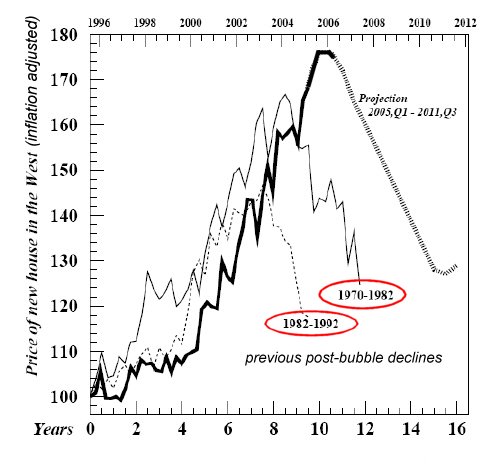
The media has started to cover the plight faced by the poor fools at the bottom of the debt mountain--those holding option ARM mortgages about to re-set to unaffordable--but the middle class will start feeling the heat in 2007 as well. For it is the middle-class which fell for the con of "investing" (i.e. speculating) in housing. It's the middle-class dummy who owns two, three or four properties, often in distant states; for the leveraging of equity into stunning piles of debt was held out as the key to wealth accumulation. Alas, it's actually the key to bankruptcy and debt-serfdom, and all that will begin an agonizing, tiresome, teeth-gnashing seemingly endless decline as 2007 hits the mid-point. Even the wealthy won't be immune, once the stock and bond markets start their declines. In one of the greatest cheerleading, hubris-packed covers of all time, Barrons announced that a new age of unprecedented U.S. prosperity is underway: The story gloats about U.S. wealth growing by $3 trillion a year--the result of a 4-year long bull market in stocks, a soaring bond market cheering the end of interest rates upticks, and a real estate market in the fulsome bloom of a staggeringly inflated bubble. But did someone forget to mention to the cheerleaders that wealth can fall as quickly as it arose? The cheerleaders at Barrons apparently neglected the possibility that the stock, bond and real estate markets might actually decline in unison, deflating the very wealth they're lauding as a permanent feature of the American elite. Since the wealthy own some 70% of U.S. stock and bond assets, the decline in those markets will take down the wealthy, not Joe Schmoe (who's up to his neck in mortgages). Analysts with a long view of financial history like Louise Yamada have been on record since 2000 warning that real estate bubbles take much longer to pop and cause far more widespread financial ruin than stock market bubbles because the losses are spread over a wider range of ownership. In other words, almost 70% of Americans own a home, which constitutes in most cases the vast majority of their assets. The stock market, largely owned by the wealthiest 10% of the citizenry, basically only impacts the wealthy when it blows up. Ms. Yamada was fired by Solomon Smith Barney a few years ago for this kind of analysis, as it simply wasn't the 100% Bullish optimism the firm required to lull customers into complacency. 4. The meltdown of China begins. The cheerleaders in the financial press have flogged "the China miracle" to death for years. Why? Because China has fueled the gargantuan profits reaped by U.S. companies in the past five years. In order to provide employment to tens of millions of rural citizens desirous of the "good life" they see on TV, China has accepted the very worst, the most destructive and the least profitable parts of the global production machine: low-margin, capital-intensive, highly polluting, high-risk/cyclical industrial production. But let's let a cheerleader from the above Barrons article state the reality himself: In return for their new (industrial) prominence, these countries are willingly importing much of the risk and cyclicality from platform economies like the U.S. Reliance on manufacturing is eminently preferable to that most risky of activities -- agriculture. Indeed, millions of unneeded farm workers are streaming into Asian cities, seeking better jobs. "In effect, China is trading job growth for the profits flowing to U.S. and other platform economies," Louis-Vincent Gave notes. 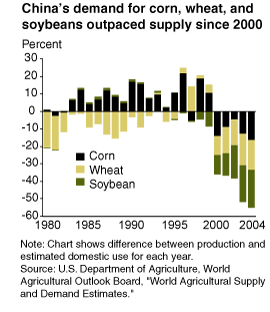
Nice bit about the risks of agriculture, but you can't eat a Bratz doll for dinner. China is busy building over its prime farmland along the eastern seaboard, ultimately paving the way to food shortages as more and more grain is imported and given over to meat production. In the meantime, they're sacrificing their environment, the health of their citizenry, and their profit margins to plump up U.S. corporate profits every quarter, for a record-breaking 18 straight quarters of double-digit profit growth. Did it ever occur to the self-satisfied cheerleaders that the Chinese might tire of this lousy deal? Recall that they also have to fund our obscene deficit by plowing all their reserves into U.S. Treasuries and other debt. And all this largesse to U.S. companies and consumers is provided for 17 cents a doll: Labor group reports harsh conditions at Bratz dolls factory. Oh, but it's really not a bad wage compared to nothing, blah blah blah. The Yangtse dolphin might beg to differ, only it went extinct in the past few boom years, erased by the usual ills of polluted waters and over-fishing. This rare creature is only a precursor of the environmental damage being absorbed by China as its leaders attempt to solidify their power on the distribution of wealth to the 900 million Chinese with little to their name. Now that the West has off-loaded all the risk of cyclical downturns to China, well, what do you reckon will happen to China in the "downturn of 2007"? Apple lays off 100 people in its cushy Cupertino HQ, and 5,000 factory workers get axed in China. Repeat 10,000 times and you get the picture. Just how bad a deal this "boom" has been for China will only start becoming visible in 2007. 5. The Political Con blows up. The political leadership of this nation has done a masterful con job on the public for the past 6 years, dangling an emotional red-button issue in front of the masses time and again to distract them from reality. Forget Iraq! The real issue is... uh, lemme see, Karl? Whatcha got this time? Immigration! Yes, it's immigration. All those guys who pick your lettuce, oranges and veggies, and toil in the slaughterhouses? They're bad news, taking jobs away from "real" Americans... Oh, and by the way, unemployment is 4%, which means anybody willing to work who isn't saddled with a felony arrest record longer than their arm has a job. Woo-hoo! Aren't we doing a peachy-keen job? So who's gonna show up to replace the 10 million workers we send home? I dunno. You want to bend over all day in the hot sun for seven bucks an hour? Well, who does? "Real" Americans? (giggle) When the wheels really start falling off--in Iraq, in the housing and the stock and bond markets--then the citizens who have been so easily distracted by the red cape--abortion! Immigration! Flag burning! ad nauseum--will wake up when the sheriff comes to their door to evict them and repo their truck. "Sorry, folks, just doing my job"--that will be the great catch-phrase for 2007. 6. The Federal deficit explodes. Are you sick of hearing about how deficits don't matter? Maybe you're sick of hearing about deficits. Either way, the one thing we can safely predict about the economy imploding in 2007 is that tax receipts will drop even faster, because it's fat profits which have fueled the growing tax receipts of the past 5 years. Once profits--from house flippers, corporations, stock speculators (oops, I mean "investors")--dry up, so do tax revenues. 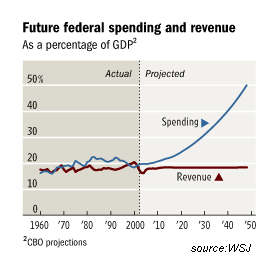
Then the spending and entitlement chickens come home to roost: GWOT (global war on terror), Iraq "reconstruction," Medicare drug benefits, retiring Baby Boomers hitting Social Security, etc. etc. Spending explodes even as revenues drop. The Big Con has been set here, too; billions of spending is routinely delayed a few weeks and shoved into the next Federal fiscal year. Cute, but all cons come to an end eventually. 2007 is the year of reckoning for the "budget deficits don't matter" crowd. 7. Crime expands beyond the inner city. I noted here last week the apparently Republican Party line which uses the horrific U.S. murder rate to trivialize the combat deaths in Iraq. The flip side of their "argument" is that they're also trivializing the victims of crime in urban America. In just one city of 450,000--and there are many with the same urban ills--Oakland, California, 150 people were murdered, virtually all by guns or assault rifles (i.e. machine guns), and 674 were seriously wounded (i.e. "nonfatal shootings.") While this mayhem is of concern to big-city mayors and the African-American and Hispanic communities who bear the brunt of this senseless slaughter, the national politicos could care less. Inner-city citizens don't vote much, so they're marginalized. And since the crime--at least up to now--has stayed largely in the urban core, suburban dwellers don't care much, either. But if times get tough, then crime may well move beyond the borders of the urban core. The old joke had it that a Republican is a Democrat who got mugged, but the Republicans have overseen a massive war on drugs even as they turned a blind eye to the assault rifles flooding urban America. "Tough on crime," indeed. The real "weapon of mass destruction" globally is the assault rifle, and it's not just people in Africa or Iraq who suffer the consequences of cheap ammo and readily available combat weaponry; look no further than urban America: Life is good after brush with death. December 22, 2006 Will This Be A More Enlightened Christmas? 
Just in time for Christmas, I received this wonderful commentary from reader (and parent) L.N. on retail sales and the holiday spirit. I think retailers knew this year would be a challenge. Consumer attitudes are changing (housing expenses, rising taxes, inflation, medical expenses, cost of utilities???). Disregard the cheerleading as exactly that; I know they sense that all is not well.Thank you, L.N., for this report, and I sincerely hope some true Christmas spirit does cut through the retail trappings. And thank you, readers, contributors and correspondents, for your support of this humble outpost on the Web. December 21, 2006 Now Is The Winter of Our Discontent As you know--because you are one of them--this humble site has an astonishing number of accomplished, savvy, experienced readers who write with uncommon clarity. As a result, I often reprint readers' lengthy comments in their entirety. I will be reprinting reader comments over the next few days which address topics of importance. It is without pretension that I quote the first line of Shakespeare's Richard III, for it is both the first day of winter and yet another day in our nation's long descent into a winter marked by structural avarice, deception and the worship of greed. Today's entry comes from frequent contributor Harun I. Coming from a veteran of one of America's most elite military units, I find it difficult not to be moved by his words. Harun wrote in response to the December 19 entry, "Defeat and Over-Confidence." Today¹s post (12/19/06) is near and dear to my heart. I read Imperial Hubris: Why the West is Losing the War on TerrorThank you, Harun, for this thought-provoking commentary. December 20, 2006 When Virtuous Cycles Turn Unvirtuous Long-time correspondent S.B. recently recommended the book The Dollar Crisis: Causes, Consequences, Cures I would characterize the past decade of booming imports, rising trade deficits and lower interest rates as a "virtuous cycle": 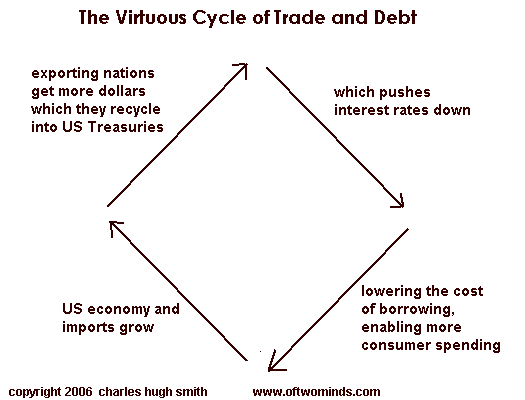
If (or when) the U.S. economy stumbles into a recession, the the cycle becomes "unvirtuous," i.e. a negative feedback loop of ever-rising interest rates, ever-sinking U.S. economy and thus ever-lower imports: 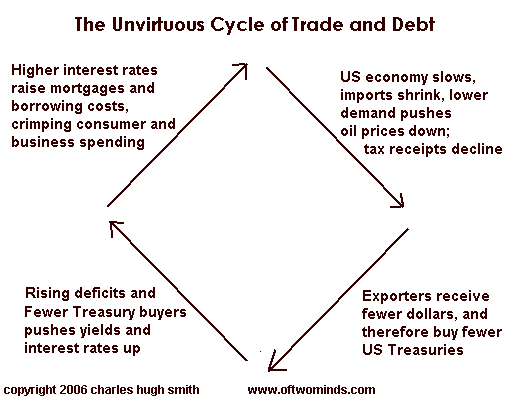
For context, let's turn to a link which S.B. kindly provided, Prudent Bear's Guest Commentary by Richard Duncan which I excerpt here: As we have already seen, the US Current Account deficits are causing an explosion of the global money supply which, in turn, has been responsible for the rise of a series of bubble economies that leave systemic banking crises and deflation behind when they inevitably implode.It almost goes without saying that the explosion of global money supply and subsequent low interest rates fueled a U.S. housing bubble which enabled consumers to borrow vast sums of equity from their homes. Now that housing is no longer rising (or even dropping in many locales), consumers' ability to borrow and spend has been severely crimped. This alone may trigger the "unvirtuous cycle" described above. Thank you, S.B., for the book recommendation, the link and a wealth of important topics. A special thank you to the reader who submitted my story How To Buy a $450K House for $750K to reddit.com, a link which brought nearly 10,000 new readers to this humble site. December 19, 2006 Defeat and Over-Confidence: An essay The self-fulfilling nature of a sense of defeat is well-known; so is the hubris of supreme over-confidence. Flyers in World war II's 8th Air Force suffered casualty rates of about 50%, as did U.S. submariners operating in the Pacific Theatre. Some survivors reported an eerie awareness that certain crews would not be returning, based solely on the actions and mood of the crews prior to departing. This foreboding of defeat is well-known in the trivial faux-combat world of sports as well. Yet the apparently opposite mood of supreme confidence leads to the same destination: defeat. Such hubris often results from a leader or leadership cocooned from reality by an inner circle of sycophants and toadies. As reported in Foreign Affairs and elsewhere, the final days of Saddam Hussein's regime were marked by pure fantasy. Telling the truth in a demonic kleptocracy ruled by terror could cost your life, so Saddam's generals continued to report one fantasy repulse of American invaders after another even as U.S. tanks were rolling through the outskirts of Baghdad. One wonders if a similar fear of political exile is powering the fantasy-world which is painfully obvious inside the White House. Here is hubris defined to perfection: the Army Chief, Eric Shinseki, who reported that 250,000 troops would be needed to secure post-invasion Iraq, was summarily sacked for daring to speak the truth to his political overlords. (This is fact, not politics; Media ignored Bush administration flip-flops on U.S. troop level increases in Iraq:) On February 27, 2003, Deputy Defense Secretary Paul Wolfowitz rejected the claim of then-Army chief of staff General Eric Shinseki, now retired, who predicted that "Something on the order of several hundred thousand soldiers ... would be required" to provide adequate security in a post-invasion Iraq. Wolfowitz said that Shinseki was "wildly off the mark," and that he was "reasonably certain that they [the Iraqis] will greet us as liberators, and that will help us to keep [troop] requirements down." Wolfowitz's position was shared by Defense Secretary Donald Rumsfeld, who predicted that post-war troop levels would be lower than what was required for the invasion of Iraq.General Shinseki lost his lower leg in combat in Vietnam, but those who had "other priorities" than service during the troubled Vietnam years saw fit to fire him in a most dishonorable fashion. We are told that our nation's leadership expected Iraqi citizens to shower our conquering troops with huzzahs and garlands. What of the obvious challenges of securing a nation of three warring factions, of a nation stripped by a kleptocracy and with a poorly-maintained and recently bombed infrastructure, of a nation ruled via terror by a religious minority? Did nothing of reality seep through the fantasy-world constructed in the highest levels of our government's leadership? Apparently not. This weekend two Republicans, in independent conversations with me, dismissed the 3,000 U.S. casualties of Iraq as "less than the number of people murdered in L.A. in the same time." So the justification for holding leadership unaccountable for one fatal hubris after another is now a non-sequitur, that because battlefield casualties are less than the nation's immense murder count, then they can be dismissed? I suggested to both men (yes, they were older males) that the value of that statistic (even if true) depended on whether the dead soldier was someone you'd loved. Somehow I find it cold comfort to dismiss battlefield casualties with an airy reference to the murdered of urban America. One of our younger friends married a Marine officer, and now, shortly after the birth of their second child, he has orders for Iraq. This is not an uncommon story, and like so many other Americans--not the elites who know no one in uniform, but those of us who do--we can only hope he returns alive and with his limbs and mind still functioning. One can assume the hedge fund managers earning $30 to 360 million each for growing the wealth of the already-wealthy do not know a soul serving in Iraq. Unlike the Americans who more often than not join the military to gain education benefits they simply couldn't afford otherwise, the hedge funders are buying mansions around the globe and throwing parties which cost millions. By all means, read this account from yesterday's Wall Street Journal on the excesses of hedge fund managers. A friend of mine was contracted to perform a slice of the marketing for an exclusive resort on the Kona coast of the Big Island of Hawaii, and he toured one of the $20 million resort homes (i.e. a second, third or fourth home) being offered for sale. The Kailua-Kona airport, he reports, is often so crowded with private jets that finding space to park additional luxury aircraft is now a problem. The exclusive resort's golf club fees were recently raised, at the behest of its members, from $15,000 a month to $20,000 a month, in order to keep the rabble out. This is not satire; it's reality. Lest we forget the obvious: hedge funds create no products or services; they are entirely speculative paper operations. Those with a nose for history will recall the heady days of speculation which led up to the crash of 1929; those with a literary bent will recall The Great Gatsby. If anything characterizes the plummy world of hedge funds and their clientele, it is the hubris of over-confidence that risk has been vanquished. One wonders if the astonishing hubris of our political leadership--heedless of historical realities, and so much else--is mirrored by the hubris of the hedge fund crowd and their assumption that risk has been banished from their fantasy world of private jets, $20 million resort homes and million-dollar parties. December 18, 2006 Will Retail Sales Be a Lump of Coal? I can already foresee the excuses which will pour forth after "disappointing" retail holiday sales numbers are finally released: gift certificates are only counted when used in January, Internet sales weren't counted, etc. Fine; then lump January and December sales together to catch the gift certificate receipts, and include the web orders placed in December, too. Then you'd have a "no excuses" number. While the financial press is serving up heaping after heaping of cheery news, here's what readers are seeing in the real world: Harun I.'s note in your December 13 posting on holiday shopping (or the lack thereof) prompts me to offer another bit of anecdotal information. Except for groceries, I do most of my shopping on-line -- books, music, movies, clothes, contact lenses, medicine, computers, wine, even big-ticket items like living room furniture -- so I get a ton of e-mail offers from the sites that I've done business with. What has really struck me over the past few weeks is not only the sheer quantity of the "special offer" e-mails coming in, but the increasingly generous concessions that on-line retailers seem willing to make, especially in the area of shipping ("free shipping for the next five days!" "free FedEx second-day through the 17th!" "free shipping on all orders over $50!"). Even L.L. Bean, which years ago disappointed me when they started charging for regular shipping, has had to make concessions for the holidays. The overall tone strikes me as almost desperate -- you don't carpet-bomb the ether with discounts if business is booming. Perhaps this is another little indicator that the canary down in the coalmine has been feeling some shortness of breath lately?Next up is correspondent Aaron K.: I went out mid last week, early in the mid evening (after rush hour) to do some shopping. Hit Best Buy and Target. I was shocked: it was dead.How do we reconcile the giddiness reflected in the stock market and media with reports like these? Are people truly embracing the Web for much of their shopping, and retail sales will surge as predicted, despite the empty stores and malls? Perhaps, but perhaps not. Note: In the spirit of disclosure, some weeks ago I noted that I had bought puts on the DJIA and calls on gold. Both speculations have lost money, going in the opposite direction. Moral of the story: I'm a idiot, a moron, a fool, etc. Do not touch anything I own with a ten-foot pole. December 15, 2006 Round Dwellings  Although famously ill-adapted for rectangular furniture, there is much to delight the
senses in round dwellings. A recent survey of Chinese housing types led me to
Ronald Knapp, who has authored or co-authored a number of books on Chinese vernacular
architecture--several of which are published by the press of my alma mater, the University
of Hawaii.
Although famously ill-adapted for rectangular furniture, there is much to delight the
senses in round dwellings. A recent survey of Chinese housing types led me to
Ronald Knapp, who has authored or co-authored a number of books on Chinese vernacular
architecture--several of which are published by the press of my alma mater, the University
of Hawaii.
These large-scale apartment buildings are found in Fujian Province--a locale I hope to visit some day, just to explore these charming multiple-unit round dwellings. 
As you can see from this plan, the basic design idea is ancient: the exterior walls have only one gate and few other openings, providing a strong defensive posture. The interior courtyard provides light and a safe common area for residents. 
Here are the Ronald Knapp titles which I recommend. They are written in the typical dry academic style, but the illustrations and information are topnotch: China's Old Dwellings House Home Family: Living and Being Chinese Chinese Houses: The Architectural Heritage Of A Nation The Chinese House: Craft, Symbol and the Folk Tradition Modern multi-story round buildings are not common, but they do exist; one of the most famous is the Capitol Record building in Los Angeles. Here is a photo of a residential tower built in the late 60s with a clearly Chinese-inspired courtyard in the center. (photo courtesy of my friend and photographer Ian Lind over at ilind.net. 
December 14, 2006 More on ETFs A number of readers have requested additional information on ETFs--Exchange Traded Funds. Astute reader Peter F. was kind enough to offer us an excellent explanation of how ETFs actually work: Exchange-Traded Funds are essentially open-ended mutual funds that trade on stock exchanges. Each fund is a trust that holds specified assets, typically shares of stock; the shareholders of the ETF are the trust’s “beneficiaries.” Where an ETF differs from a closed-end mutual fund is that the “trust agreement” requires the managers of the ETF to intervene in the market to keep the market price of each ETF share within a narrow range around its net asset value (value of the trust’s assets, the underlying stocks, divided by all outstanding shares). Note that closed-end mutual fund shares, unlike ETF shares, may, and do, sell at significant discounts from, and premiums to, their net asset value.Thank you, Peter, for this description of a widely owned but poorly understood investment vehicle. For those seeking the recent post on the housing bubble's stairstep collapse that columnist Jim Willie was kind enough to mention, here it is: Housing's Stairstep Descent. I just updated the Archives, which lists every entry of the past year by category. If you haven't skimmed the lists, you might enjoy browsing. Who can resist "One-Word Titles"? December 13, 2006 More Portents of Doom Let's start with an incisive excerpt and chart from this week's Barrons: the "cliche alert" chart suggests that a sudden spike in soothing financial cliches--"the goldilocks economy," "soft landing" and "global liquidity"--portend stock market doom. 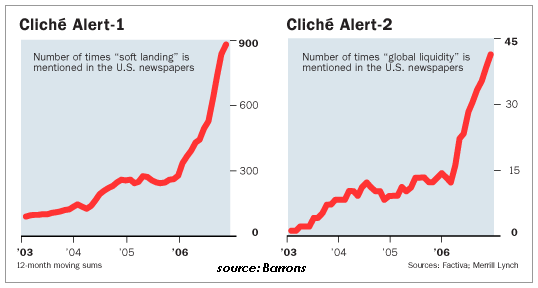
Here's a few choice paragraphs from Up and Down Wall Street: IN HIS LATEST CHILLY BLAST FROM UP New Hampshire way, Fred Hickey, proprietor of the wonderful High-Tech Strategist and member of the Barron's Roundtable, muses on the disconnect between Wall Street and the real world, like Nashua, which he calls home. The differences have never been greater, he laments, and the wealth disparity is at the highest level in history. By way of illustration, he cites the fact that the average pay of the top 126 hedge fund managers last year was $363 million, up some 45% from the year before. He doesn't tell us what the annual paycheck of the average working stiff in Nashua is, but we suspect it's somewhat less than $363 million.The article goes on to note that Mr. Hickey suggests shorting all the darlings: Google (GOOG), Research in Motion (RIMM), etc. For a single manager to "earn" $363 million--a sum far larger than the net profits of many major corporations--is truly obscene. If you absolutely must narrow all the portents of doom down to one, this is it. Next up is a report from the critical Holiday shopping/retail sales front from correspondent Harun I.: Anecdotally, my wife reports holiday shopping traffic is down substantially in my area. She is hearing the same thing from her sister and her colleagues. Of course there may be an increase in online shopping. I think we would agree that online shopping will not make up for the overhead of bricks and mortar stores. I went out with her on Black Friday and was surprised that it we had no problem with parking or checkout. The mall was normal.When will the financial press begin covering the disappointment which is this Holiday shopping season? Soon? Or after the market has already sniffed a whiff of disaster? No doubt the latter; cheerleaders, after all, are still gamely cheering the home team on even as the opponents (in this case, reality) are stomping their exhausted players and easily scoring again and again (i.e. making huge profits by shorting the market). For a truly disturbing--and therefore fascinating--comparison of the USSR's demise and a depression-like collapse of the U.S. economy, let's turn to a lengthy report which was forwarded by two frequent contributors, Our U.K. Correspondent and Jim W., our RV "Wheel Estate" Correspondent: USSR and USA: Closing the 'Collapse Gap'. On another note: Readers have recently requested links to previous entries; I list them here in the event others may also have missed the originals: Columnist Jim Willie was kind enough to mention a recent post on the housing bubble's stairstep collapse; here it is: Housing's Stairstep Descent. Another reader asked for the pancake recipe submitted by reader Chris H.; here it is: Light-As-Air Pancake Recipe. Enjoy! Last but not least, here are two blatantly contradictory holiday recommendations: Can't think of what to give people who already have everything? Hate shopping? With Amazon.com gift certificates, they pick their own gift and love you for it. Don't waste money on useless gifts this year! Buy yourself some investment gold instead at the online gold vault BullionVault.com. December 12, 2006 What If Rates Don't Drop? And Other Portents of Doom The financial media and raftloads of sundry pundits assume the Fed will lower interest rates shortly. But rather than pontificate, let's look at some charts. What we have here are two charts which reflect the market's assessment of where rates are heading. The first depicts the yield on Treasury bonds, the second the value of long-term Treasuries. The two work like a see-saw. When rates are rising, the yield rises while the value of existing long-term bonds drop. When rates are falling, the value of current bonds rise (because their higher yield makes them more valuable than lower-yield new bonds) and yields correspondingly fall. 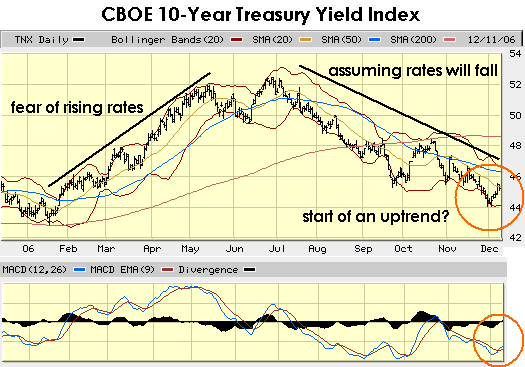
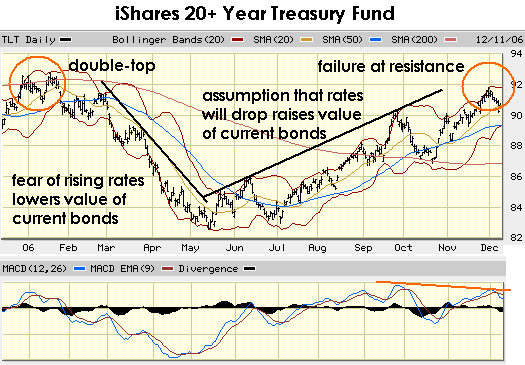
It's impossible not to notice that both charts seem to have ended their move, and are starting to reverse direction. What this means is the market seems not to believe the pundits and all their blather about how rates have to drop because the economy is slowing. Au contraire, mon ami--these charts reveal that the market is now beginning to anticipate a possible rise in rates. Does this make sense? Perhaps not in the standard scenario, but this isn't a standard scenario. At no other time, in this nation or any other, has the financing of gargantuan debt remained so heavily dependent on the willingness of foreign investors. The only historical analog I know of is Imperial Spain, which in its declining decades relied heavily on Dutch lenders to fund its deficits. The collateral, of course, was the gold and silver pouring in from Spain's New World possessions. Does the U.S. has equivalent collateral for the trillions in dollars we've borrowed from the Chinese, Japanese, Saudis, et. al.? No. That should make you wonder if our lenders are entirely happy holding trillions in unsecured debts. Yes, the Treasury can always print off another trainload of dollars to pay the foreign investors' interest, but isn't this the classic recipe for inflation? And what happens then? Rates rise--which is precisely what these charts are indicating. The stock market won't appreciate the demolition of the fantasy that rates will soon be falling, nor will the bond market. But let's not stop there--let's look at some other portents of doom: Correspondent Jed H. noticed a sudden spike up in Mr. Softy (Microsoft- MSFT) in the last few minutes of trading on Friday: As you have Posted stuff RE: Manipulated Stocks / MKT, just have a close look at yesterday's "Moves" in MSFT ! It traded "Flat", at about $ 28.90 for ~ 5.5 hr, & then started UP in last Hour, followed by a "SPIKE" up ~ 2% ( ~ $0.50 to $ 29.40 ) in last ~ 15 min of trading -- TWICE Avg Volume to ~ 108 MILN shares, vs 59 MILN ; I found it "only takes" ~ $1.50 BILN & ~ 50 MILN shares to move MSFT ! What is your take ??! ( NOT, orderly stock pricing ?)Large traders don't build positions in the last few minutes of trading; that's called "painting the tape," when the big traders push a stock in the direction they want the "greater fools" to believe is the "market direction." Next up, astute reader Bruce H. sent in this sobering fact: Was reading Doug Noland's recap of Q3 flow of funds when the following caught my eye - it's from Daniel Hauck at Bloomberg:As noted here earlier in the month: when insiders are dumping like crazy, the top is rather glaringly in. We've also noted here the "megaphone top" formation and the big divergence between MACD and RSI (dropping) and the indices' price levels (rising). For younger readers, we might also mention that 1987 was famous for a 22% drop in the Dow Jones Industrials--not for the year, or in a month, or even in a week--but in a single day. If you really want to believe the happy story about how great everything will be because the Fed is poised to drop interest rates, be my guest. But are there any charts or other evidence which supports that thesis? December 11, 2006 Warning: Sporadic Posting Ahead Due the usual demands of the season and my push to complete a big personal writing project (otherwise known as my fourth novel), postings here over the next few weeks may be sporadic. It will be interesting to see what transpires in the remaining weeks of the year. As always, Thank you for your readership. December 9, 2006 Saturday Pot Pourri: Gifts and Gold Is anyone else an utterly unmotivated, lazy shopper like myself? If so, I have the solution to all your gift-giving needs. And you can do it all right from this site. I'm talking about Amazon.com gift certificates. 
What I like about amazon.com gift certificates is that you send them via email, so it's super-easy--and you can include an e-card if you want. It takes about 20 minutes to do all your holiday shopping, and the recipients love them because you can get just about anything on amazon nowadays--sheets and towels, cookware, toys, sports stuff, electronics, DVDs and for those folks on your list who still read, books. According to my server logs, there are a couple thousand regular readers of this humble site, and if all of you pop for $100 of gift certificates, that would really make my holiday cheery. I mean, make your holiday shopping cheery and easy. Last weekend I accompanied my Mom and sister to Macy's San Francisco. (When I told one of my buddies, he gave me a look like "Are you insane?" It was my gift to the ladies, guys. You know how it is.) Males know how this works: there's seven floors or whatever of crap to rummage through, and about four chairs in the entire building. Luckily, I only had to wait 20 minutes to snag a cushioned chair, where I promptly took a nap. Some other guy had the only other seat on the floor, and he too snoozed out. Afterward, my sister said she was sorry I didn't get anything for myself. That was sweet of her, but I already did my entire year's clothing shopping at Costco about six months ago in approximately five minutes. (Waiting in the cashier's line took longer than the selection process.) When the jeans and sneakers are shredded, then I go back for more. Simple. But I stray from my purpose, which is to recommend Amazon.com gift certificates as the answer to all your holiday shopping needs. Seriously--if you're not much of a shopper-- check it out. Who needs the madness of malls and department stores? Why buy a specialty store gift certificate when amazon has pretty much everything? My niece and nephew haven't complained, and that's proof of concept. Recently, another friend asked if I was a "gold bug" i.e. an investor who believes in owning as much gold as I can. I said, no, I wasn't. But I did say I thought it prudent to own some actual physical gold and some mining stocks or a gold ETF, and maybe some silver if you follow that metal or consider gold and silver roughly equivalent. As shown here this week, all currencies are declining against gold. Nuff said. If you decide to buy some actual gold but don't want to pay the steep commissions required to buy coins, or don't want the hassle and expense of a security deposit box, then buy gold online at BullionVault.com. This outfit was recommended to me by longtime reader and erudite contributor, Our U.K. Correspondent. The company holds the gold--yes, your gold-- in vaults in London, New York, and Zurich (your choice), and you can buy gold in small quantities (grams) and easily buy and sell your holdings over the Internet. Their commission is modest, I think, but you can check it out yourself. I like this system, and I found their website easy to use. With a one-time setup, I can buy gold directly with funds from my bank checking account. This is my opinion, but like amazon, I do receive a small commission from bullionvault.com should you buy gold via this link. Important Disclosure: Though I earn a small commission on Amazon.com books and gift certificates and gold from BullionVault.com purchased via links on my site, I receive no fees for any links on my site. There is no paid advertising on this site. That's my policy. I recommend what I think is of value, and you check it out for yourself. If you like it, then it's nice if you buy through this site. If you don't, that's OK, too. If you want to show your appreciation, then your purchases at amazon or BullionVault.com do generate small commissions for this poor dumb writer. Or if you're feeling very adventurous, then consider giving a copy of my novel I-State Lines as a gift. My favorite independent bookstore in Iowa The Kaleidoscope will take your order online and ship it free; or you can pick up I-State Lines Or if you prefer to send out specific titles as gifts, check out the 100+ books and movies on my Recommended Books/Films list. What makes this fun is that amazon added a cool "mouse-over" feature which pops up information on the title when you roll your mouse over the link. Plus, don't take my word for it--click on the title and read other folks' reviews. It's your choice; I'm only trying to help make your gift shopping as painless as possible. OK, now on to the theme of the above photo. Is this as glowing an economy as the cheerleader media would have you believe? Astute reader Bob K. filed this retail report: Seems like you had a comment this last week or two about how the media always paints a rosy picture.... well, I was shocked this week: on two occasions, (one tonight, just a couple of weekends until Christmas) out at stores for Christmas shopping. Almost completely deserted, no people at all. Early December, freezing cold where I am at and Old Navy is selling outerwear 50% off and no one was buying. Huge discounts on clothing. At a mall - most stores I passed had clerks standing idly about, no customer in sight.Thank you, Bob, for a first-hand account of what may well turn out to be a stocking-full-of-coal Christmas. Department of Corrections: Knowledgeable reader Z. was kind enough to correct an error I made in yesterday's post regarding ETFs. This is just plain wrong:That's an important distinction, and I am glad to know about this. Thank you, Z. for this information. December 8, 2006 Risk, Manipulation and Liquidity As I write this Thursday night, I have no idea what the stock market will do on Friday. But I do know the risks of an implosion are building daily. My own view is that a sharp spike in volatility (i.e. a sudden downdraft in the market) could happen within the next week or so, not months from now. But I tend to be impatient, so I might be completely wrong. I have two reasons to think this: one is short-term, the other is long-term. A few days ago frequent contributor Jed H. sent in this link on a "megaphone top" chart formation which suggests a major market top is in place: The Dow Industrials are Wrapping Up a Pattern Similar to 1929 (11/3/06) Now scroll down to the 12/4 post on Chris Johnston's trading blog ("I Am a Futures Trader," recommended by longtime reader S. Berkland) for his description of the same pattern only on a short-term chart. This suggests a big drop is imminent. 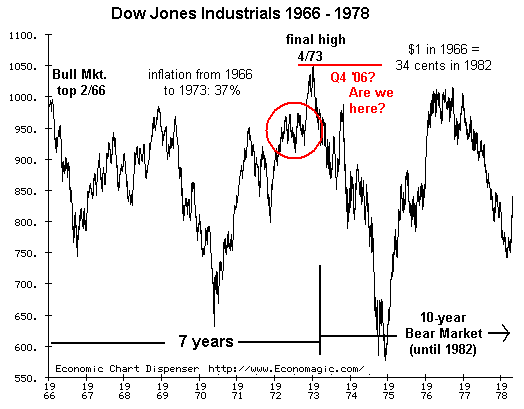
My longer-term evidence is the book When Genius Failed: The Rise and Fall of Long-Term Capital Management Speaking of the PPT, reader David S. sent in more evidence that a semi-official Plunge Protection Team is intervening in the stock market, not just in times of extreme crisis like 9/11, but routinely--like, say, this month: Government Intervention in Stock Market Is Detailed by New Report, GATA Says 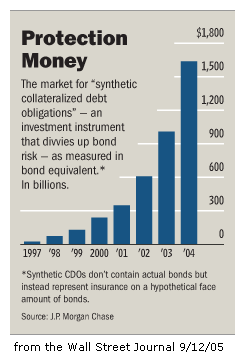
As for the size of the risk facing global markets: Jed H. also sent in this link to a Bloomberg article which states that global financial derivatives now total a staggering $370 trillion, or 9 times the size of the entire global economy and 30 times the size of the entire U.S. economy: Derivatives Trading Soars to $370 Trillion, BIS Says. Here's a brief summary of risk and liquidity. Liquidity has two meanings in the financial world: when we read about "excess global liquidity," this refers to the vast quantity of cheap (borrowed at extremely low interest rates) money sloshing around the global economy, looking for places to earn a high return. Much of this comes from the now-ubiquitous "Japan carry trade" in which global players borrow yen at 1% in Japan and then swap it into dollars and buy higher yield securities in the U.S. or elsewhere. The other meaning of liquidity is the presence of ready buyers and sellers in the stock market. A stock or market with few buyers and sellers has low liquidity, meaning that when it comes time to sell your shares, there may not be enough buyers to take the shares off your hands. In the reverse case, stocks with very few shares outstanding also have low liquidity, meaning that when you want to buy, and there aren't many shares available, the price can jump quickly as buyers compete for the few shares for sale. This is the classic "short squeeze" in thinly traded stocks, in which desperate shorts (speculators who sold shares they didn't own, hoping to buy them back at a lower price) must buy some shares to "cover" (replace the shares they sold) before the price rises further. Their buying, of course, creates a self-fulfilling prophesy as prices shoot up, which causes other shorts to panic and buy at any price, and so on. The super-hedge fund Long-Term Capital Management blew up in 1998 largely because liquidity disappeared. There were simply no buyers for their tens of thousands of derivative positions (bets). Here's the really pernicious part. As a crisis or market plunge deepens, liquidity (buyers) dries up because nobody is dumb enough to "catch the falling knife," i.e. buy a security which is dropping by the minute, hour and day. But every security must be priced, even if there's no buyer. Let's say I have a derivative linked to, say, a mortgage backed security (bond) made up of high-risk subprime mortgages. In a financial meltdown, investors would realize that these high-risk borrowers will default in droves, driving the value of this bond to near zero. But a derivative isn't the actual security--it's a specialized, thinly traded leveraged bet on the direction that bond will take. Let's say I bought the derivative for $100 a contract. If the bond moved up in price, my contract might double, triple or even quadrupal because it's basically multiplying the actual moves in price by 100. If the bond moves up $1, I make $100. Let's say I want to sell, but there's no buyers. Then the quoted price drops precipitously as the market tries to find buyers. As a result, maybe my derivative is quoted at $50--a loss of 50% for me. I complain, "Hey, this derivative is worth at least $90!" But guess what--nobody cares. The prices is set by the buyers, and if there's no buyers, then the price can drop to near zero. OK, then just hold on to the bet until the panic subsides, right? Good idea--unless you're margined (using borrowed money). When your margin gets called, you have to sell. And when does your margin get called? When the value of your holdings drops below a certain point. And how does the lender set the price of your holdings? By looking at the market. If the market has my derivative set at $50, then my portfolio has taken a huge hit. As a result, my margin/debt gets called, and now I have to sell something to raise cash. This is how illiquidity triggers a feedback loop of ever greater selling. Now I'm in a pickle, because everything I own is dropping. The "geniuses" in LTCM assumed markets were rational, i.e. independent of each other or even random. But markets are linked by human emotions of greed and fear. When one market topples, people panic and start getting out of other markets, too. This is how a house of cards built on $370 trillion in derivatives and semi-official manipulation blows up. 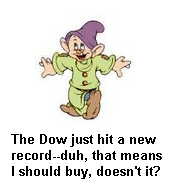
The Plunge Protection Team has been working overtime this month to keep "the Bull market rally" going, even as insiders have been getting their own money out. When the market finally turns, then we will realize how the PPT manipulation has made things worse: by propping up a sagging market, they've set the stage for an illiquid market: i.e., there's no buyers as markets drop in a free-fall. On 12/4 I posted this link to a CBS-Marketwatch story by Herb Greenberg on the coming drop in the stock market: Market warning from those in the know. What's of particular interest in the context of illiquidity and risk is Greenberg's question about ETFs. ETFs are "exchange traded funds," index or sector funds which are pools of stocks. They are basically mutual funds which are supposedly highly liquid, i.e. can be easily bought and sold on the open market like any stock. In a market downturn, sellers of ETFs will trigger selling in the underlying stocks. When someone sells an Internet ETF, then the ETF has to sell its shares of Google, Yahoo, etc. In a market downturn, who's going to be buying those ETFs? If the answer is no one, then they will add to the selling, creating the negative feedback loop of margin calls and even more selling. Lest you imagine bonds will do swimmingly as stocks plummet, read the links and comments sent in by frequent contributor Albert T.: The most interesting thing so far came from Bill Gross the Pimco bond manager. I think he is saying that bond yields will drop and risk will precipitously increase. Missed him on msnbc today but there was a quip about him saying that yields would go to 2s and 3s long term. Basically stagflation like japan had after its bubble... This is a bit scary. So far he is very very on the money. He said that yeilds would hit 5% and go back down on treasuries and thats basically what happened. Reality Check (by Bill Gross)Maybe the market will run up in giddy euphoria today, or next week, or next month...but maybe not. Please read the book and the above links before you dismiss the idea that a financial meltdown is not only possible but probable. December 7, 2006 Readers Report: Southwest Over-Building, Wacky Mortgage Business and a Long-Term Perspective A number of readers have sent in wonderful housing-related reports, links and comments. First up is observant contributor John B., with a firsthand report on overbuilding in the Southwest: As part of tour of the Southwest we were checking for over-building. Still lots of building every place we went. Bullhead City has developments going up everyplace. What a God forsaken place. I really like Flagstaff and there is a lot of building there, but there are no jobs. Who is going to buy those homes?Next up is a story recommended by another frequent contributor, Michael Goodfellow, on the astonishingly loose standards of today's mortgage business. After you read this, you will no longer wonder how the housing bubble reached such epic proportions. The party's over at Kirkland mortgage company Reader Riley T. takes a long view of the housing market. I agree with his view on long cycles. When nobody remembers a time when housing dropped, then that complacency creates the perfect conditions for a trend reversal: "permanent" up switches to "permanent" decline. We may be in the first stages of just such a decline. Here are Riley's comments: Thank you, readers, for diverse and interesting comments on the housing bubble. (Note: charts were added to illustrate points being made; they are independent of readers' comments.) December 6, 2006 Gold and the Empire of Debt The recent weakness in the dollar and the resulting strength of gold masks a larger reality: gold is rising against all major currencies. Frequent contributor Harun I. kindly sent over charts depicting this; Here are the charts for the euro, the yen and the currency generally held in esteem as a placeholder of reliable value, the Swiss franc: 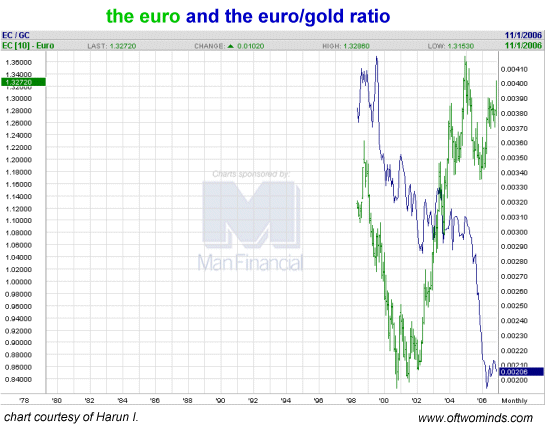
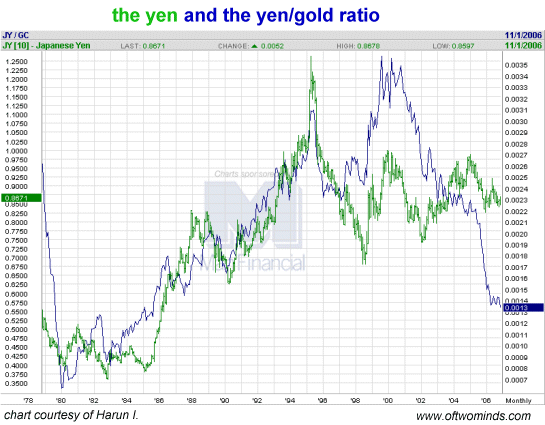
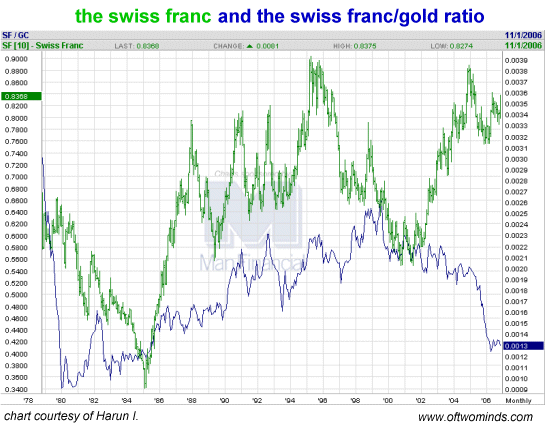
Related charts showing gold breaking out against major currencies can be found in Gold Leaves the Major Currencies in the Dust (12/4/06) What do these charts reveal? For one, a profound distrust of the global Empire of Debt. We hear a lot about the American Empire, American hegemony, U.S. hyperpower. etc. etc. But the real Empire is that of Debt, and its full partners include the oil-exporting states, Euroland, Japan, and China--virtually all the big trading players. How does the Empire of Debt work? We all know the basics: the U.S. buys virtually the entire world's exports (surplus products) and funds this $2 trillion buying spree by borrowing money from those nations with enormous trade surpluses with the U.S.: Japan, China and the oil-exporting nations. Rather than invest/dump/mis-allocate (depending on your point of view) these gigantic sums in their own economies, these players recycle their surpluses into U.S. Treasuries, in effect keeping interest rates artificially low so U.S. consumers can continue to buy oil and non-U.S. goods with borrowed money. (Note that virtually every trading block and nation runs a surpus with the U.S.--including Canada and Korea.) How dependent are the non-U.S. players on the U.S.? Very. If the U.S. "hegemon" (a favorite Chinese synonym for Empire) dried up and blew away, 25% of the demand for oil would vanish, pushing prices for crude to $10 or lower. The Gulf oil states and Russia either did go bankrupt or nearly went bankrupt in 1998 when oil was $10 a barrel, and that experience makes them diehard participants in the Empire of Debt. Japan, China, Euroland, Canada, Mexico and Korea, just to name a few, would all descend into instant recession with virtually no hope of a turnaround if their massive exports to the U.S. suddenly stopped. So what's wrong with the Empire of Debt? We all know something is fundamentally unstable about this ever-rising load of debt on the U.S. government and consumers, and the equally fast-rising accumulation of surpluses in oil-exporting nation, China and Japan. It is a deeply flawed model, and we all know the result of this "cheap money" stupendous global liquidity has been the expansion of a global property bubble of unprecedented proportions. Astute contributor John B. recently sent in a comment which I think perfectly captures the sense that a meltdown of this tremendously out-of-balance system cannot be far away. Although he send this regarding my recent entry on market manipulation, I believe it describes the precarious nature of the global Empire of Debt as well as the "Emperor has no clothes" U.S. equity markets: As I watch the market rally further today, I sit back and wonder if the rest of the world is just doing meth or has everyone else turned into a pod person. As you mention below it is rather unbelievable how the press and everyone else just accepts that the enormous supply of unsold houses will be sold. It takes years for a housing boom to bottom out. I see where foreclosures in numbers (not percent) have hit an all time high in Denver and also see similar statistics for Dallas and these are not even bubble areas. This is still overhang from the telecom boom in the late 90's. It shows how long the housing bust can drag on.Well said, John. I believe the rise of gold against all major currencies signals a widespread distrust that the Empire of Debt can sustain itself much longer. December 5, 2006 Is The Top In, or Still to Come? Frequent contributor Jed H. recently sent in two interesting links, one making the case for a recession in 2007 and the other describing a "market top" formation in the Dow Jones Industrials: The SafeHaven link below has some USA MKT / DJIA Charts and a "Megaphone (TOP) Pattern" (which is a FRACTAL Pattern), which seems to form at MAJOR MKT TOPS.Please take a look at the megaphone charts. If this analysis is correct, then the smart move would be to exit the market before the crash. A panic for the exits will undoubtedly occur at some point, and the question of "when" will only be decided in hindsight. The Dow Industrials are Wrapping Up a Pattern Similar to 1929 (11/3/06) Recession Looms for the U.S. Economy in 2007 (Center for Economic and Policy Research) 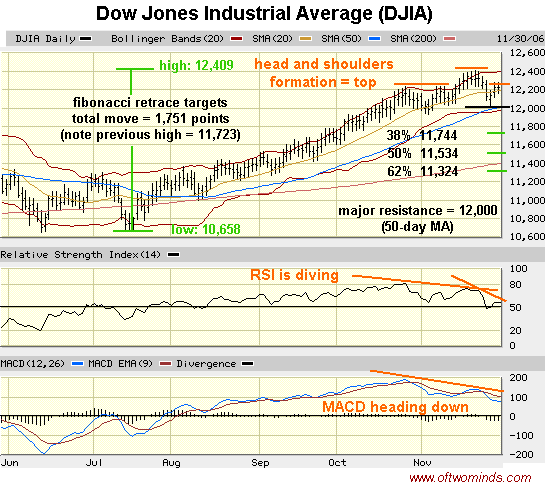
Thank you for the links and for the question, Jed. For what it's worth (no more than your own opinion, to be sure), here are my thoughts. 1. Charts cannot predict the future. Charts can indicate likely scenarios and trends, but trends can be broken even when few expect the break. 2. Nonetheless, charts are all we have. Glancing at this chart I posted on 12/1, what I saw was a head and shoulders top. However, if the market rallies, it could go back to the 12,360 level and form a double top--another topping pattern. Or, it could run up to 12,500 or even 13,000 in a new high. Or, it could fizzle at 12,300 and then descend. 3. There's two wild cards the Plunge Protection Team cannot control: the dollar and foreign investors' holdings of U.S. equities. The dollar remains in a slow-motion freefall; the big victory today is that it didn't drop any further. As I have mentioned here recently, there is an extraordinary complacency in the equity and currency markets; few seem worried that the dollar could drop below 80, or that the consequences of this weakness might actually prove serious. When complacency reigns supreme, the odds of a disruption increase. Recall the currency markets trade $2 trillion every day; if the dollar breaks down, no amount of intervention will stop it. Even the Japanese don't have that much money. 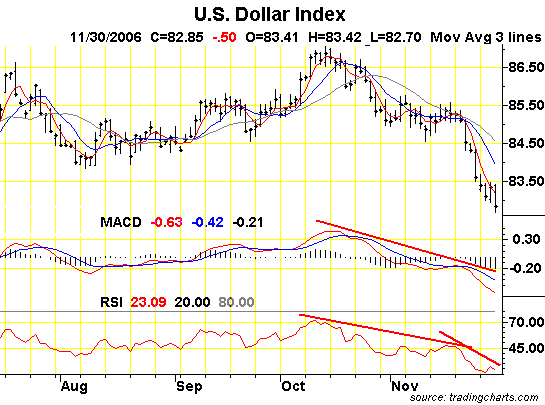
Foreign holders of dollars, U.S. bonds and equities are losing billions with every downtick of the dollar. Yet Americans, at least those writing in the financial media, are supremely confident that non-U.S. investors and central banks will continue funding our profligate lifestyles and global ambitions regardless of their losses. If I were a non-U.S. investor/banker, I would be frustrated in the extreme with this careless reliance on my forebearance, and I would be tempted to let the dollar drop below 80 (or cause that decline with some judicious selling) just to fire a warning shot across Washington's bow. Recall that owning stocks and bonds is also a bet on the dollar. Foreign holders of stocks and bonds may decide to get out while the getting is good, and sell their U.S. equity holdings before the dollar drops any further. No amount of hedge fund money could countermand such a flood of selling. 4. The VIX (volatility index) remains at record lows. While it is possible for this index to continue down to ever-lower levels, the odds get longer with every passing day that a spike of (unexpected) volatility might appear. 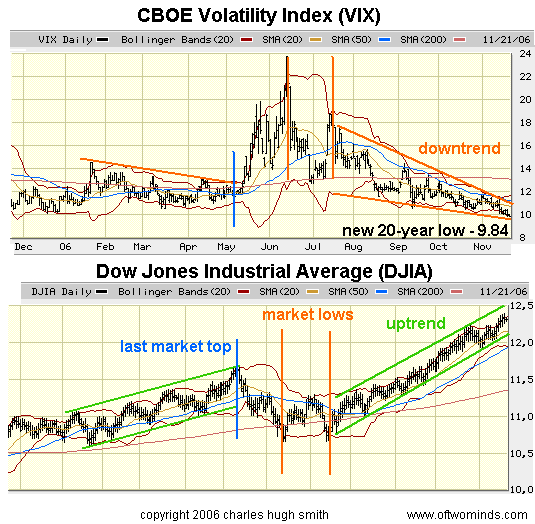
5. Nothing has worked as expected this year, so the Santa Claus Rally might yet be a victim of this anti-trend year. A very long history suggested that an important 4-year low would be reached this October (yours truly expected this to hold to historic patterns). Instead, the market ran up in a most contrarian fashion throughout October. Some feel the 4-year low has been postponed, and if this year is indeed contrarian, what better time for a breakdown than smack dab in the highly anticipated December Santa Claus Rally? 6. The cliche is that the market always acts to inflict the greatest possible damage on the greatest number of participants. A sharp downturn right now, when virtually everyone expects a continued rally through the end of the year would fit that bill exactly. Technically, the argument can be made that today's strong rally returned the indices to their uptrends. This may turn out to be true; it's also possible this rally will return to the previous high and reverse, forming a double top. Or it could plummet unexpectedly, and break all those warm and fuzzy expectations of Santa Claus enriching everyone who believes in him and his "guaranteed" year-end rally. 7. The 4 billion share volume last Thursday, 11/30, was a little-noted line in the sand. Please scroll down and read my 12/1 post for more on volume analysis. If I am correct on this, the uptrend broke on 11/30, and will not find its legs; the enormous volume on that down day fractured the uptrend, even if no one seemed to hear the snap. Though I cannot provide you with any persuasive evidence, I would not be surprised to see the market perform an unexpected swan dive in December, recover in January for one more splendidly irrational move higher, and then fall into the severe crash Jed H. described. We shall see. It's a good juncture to recall the ancient Chinese curse: May you live in interesting times. Indeed.... I remind readers that I am long gold (calls) and short the DJIA (puts). I may have my head handed to me on a platter by the market, so for goodness sakes, make your own investment/speculative decisions. NOTE: According to my web logs, the 400,000th visitor of 2006 happened upon this humble site today, and I want to thank each of you who has taken the time to stop by. I hope you have been informed and/or amused; and if not, please check in another time. We aim to surprise. December 4, 2006 Market Manipulation: How It Works Astute reader David S. recently noted the astonishing way the stock market manages to close up (or recover sharply) in the last hour of the day. Something I've noticed this week with the stock market that sure makes me think someone is manipulating the indexes - example is today - the Dow, Nasdaq, and S&P were negative most of the day but then shortly before the market closed the Dow and S&P rose to end the day positive which causes ridiculous headlines like this: Dow Rises to Another Record High (Yahoo News) 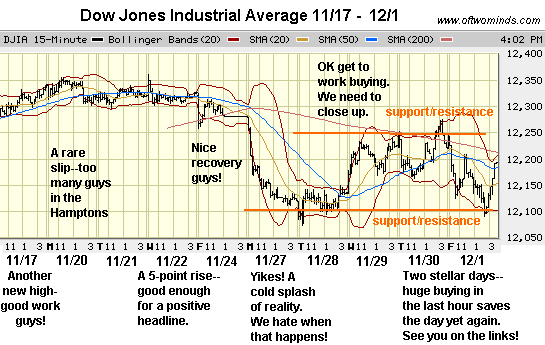
I agree, and I can easily surmise how this kind of manipulation works. Is it a conspiracy? No, just plain old simple human greed in action. First, let's establish that it doesn't take that much money to move any of the U.S. markets. The New York Stock Exchange, for instance, trades on average 1.7 billion shares a day or about $75 billion in dollar volume, about evenly matched in buys and sells. Let's say you manage $10 billion in OPM (other people's money). It's not that large a figure anymore--some families of funds manage over $100 billion. Hedge funds managing $5 billion or more are a dime a dozen. Your bonus depends on beating the market as of 12/31--or at least getting close to what your long-suffering clients could have earned by investing in a low-fee index fund. Your bonus could run upwards of $10 million or more, so this is a non-trivial game to you. Now let's say you and a few of your golfing buddies reach an understanding--not any collusion which could be proved, or recorded, just a "conversation" on the links--that each will buy $1 billion in the last hour of trading if the market is down. $7 or $8 billion just isn't much money in a $12 trillion economy or in a $6 trillion market, but it's more than enough to move the market in a major way if it's all buys or all sells. Let's further suppose that your old Wall Street acquaintance Mr. Paulson (now Treasury Secretary) had a pal call and hint that it would be a darned shame if the market dropped for three days in a row, because, well, technicians know that three days in row makes a trend, and we wouldn't want the Great Unwashed Investor to think the market was in a downtrend. Why? because you and your insider pals are selling like no tomorrow, and they need the market to stay up until they've liquidated their own shares. Here's a story from CBSMarketwatch stating that insider selling has jumped: Market warning from those in the know Muzea sees steeper declines based on lack of insider buying (11/27/06) If George Muzea is right, Monday's decline is just the start. Muzea, who runs Reno-based Muzea Insider Consulting Services, has been negative on the market for just two weeks -- the first time he has been bearish since July 24, when he turned positive. Muzea makes market calls based on the activity of corporate insiders. He's considered the grandfather of the insider-tracking industry, generally keeping a low profile to all but his high-paying hedge fund clients. But, according to Muzea, this is likely the beginning of a sharp and steep decline not unlike the one that hit the market last spring -- and maybe worse.So why does the market jump in the last hour? Because insiders are goosing prices with other peoples' money while they turn their own shares into cash. Another way of putting this is: if you could manipulate shares in a company so you could exit with a fat profit before it sank like a stone, wouldn't you do so? Come on, be honest--we all would. But only a few people have that ability, and to claim (with zero evidence) that the "markets are fair" and "manipulation is impossible" is to be either uninformed about the relatively small size of the daily trade or naive about just how few people would be needed to push the market up or down. Not only that, but as a pro you know the technicial levels you need to defend or punch through to trigger "black box" (computer) buying or selling. For instance, on Friday, December 1, the Dow Jones Industrials sank 130 points. But miraculously, in the last hour of trading the index jumped 100 points to 12,194. Support in the DJIA is 12,195, so the boys almost made their number, retrieving the index from a close below 12,100 (another support level) almost back up to the 12,195 level. Once you've liquidated your own long positions, then you can go short and start unloading your funds' shares before the deteriorating market becomes too obvious to ignore. Then as panic selling sets in, you reap immense profits on your short holdings, and put your clients' money back to work at the bottom, after the retail crowd (the average investor/gambler) has sold for a loss or miniscule gain. Then the game starts all over again. Don't think this is plausible? Then please explain why 4 billion shares traded hands on November 30--over twice the daily average--and yet the market swung from a 90 point loss to a 90-point gain and then ended with a tiny 5-point loss. With massive buying driving the index up almost 200 points from its low of the day, who sold it down for a loss at the close? Simple: the right hand bought with Other People's Money and the left hand sold its own shares. Now that the insiders are out, the market can fall. Don't believe this? Just watch the action over the next two weeks. December 2, 2006 Are Labor Costs Rising or Not? Knowledgeable contributor Aaron K. sent in an excellent commentary on the huge downward revision in Q2 labor costs (from +7% down to +2%), and gently suggested I have given too much importance to labor costs as an engine of inflation: "A few days ago, you wrote:As Aaron notes, we end up on the same page: stagflation and a falling stock market. However, I remain skeptical of the labor cost data revision; it doesn't take much imagination to discern a political agenda in such huge adjustments to data--adjustments which seems to be occurring with alarming regularity (job growth and labor costs, to name just two). Both of these massive adjustments just happen to serve a political purpose: making job growth appear strong, and labor costs benign. My own view is that the true costs paid by employers are not being captured in the statistics. Whether this is purposeful or not, the fact remains that "overhead" or "soft" costs for labor are rising faster than 2% per annum. These include the mandated benefits which employers must pay (workers compensation, temporary disability and unemployment insurance), which are usually a percentage of wages paid, and the corporate-level benefits of healthcare and pension/401K contributions. 1. Overhead costs are not trivial; they can easily amount to 100% of the worker's wage/salary. When I was a builder in Hawaii in the 1980s, to pay someone $20/hour cost us at least $35/hour--and this was with a minimal mandated healthcare plan (we paid 50%) and no vacation or retirement. First there's FICA (Social Security), then add workers comp, TDI, unemployment insurance and then toss in some healthcare and it's nearly the same as the worker's hourly wage. Worker's comp rates are very high in construction, but nowadays the medical costs paid by the employer have been rising at nearly 10% year for several years; those expenses are far larger than workers comp costs except for the construction trades. Bottom line: the non-wage expenses paid by employers have risen by leaps and bounds. For larger companies paying full pop for premium care, the insurance for a middle-aged worker with a family can easily exceed $1,000 per month. Not many years ago that coverage was under $500; a doubling of medical costs is reality for employers, but it's simply not being reflected in labor cost stats. Here in California, the worst excesses of our corrupt and inefficient workers compensation system were recently trimmed, but the bloat and the waste are still phenomenal. Costs were rising so fast that corporations were rebelling, and the Golden State was losing major employers faster than you could say "Cauleeforneeyah." With the threat of the golden goose leaving the bankrupt state even more bankrupt (don't ask), the legislature staved off enormous political pressure from the unions, trial lawyers, and the medical establishment and made some modest cuts to a system which was universally despised except by those draining huge bucks for bogus "care", bogus "training," bogus settlements for bogus faked injuries, etc. But the system is still a rip-off; workers get less, employers pay more. 2. 24 million employees--approximately 20% of the entire U.S. workforce--are employees of government. School boards, libraries, colleges, the Armed Forces, municipalities, counties, states--the list goes on and on. By and large, these workers receive handsome benefits and generous pensions as well as raises which generally keep up with inflation; as these costs escalate, the government raises revenue or cuts other expenses. Just anecdotally: fully 40% of our local library's entire annual budget is devoted to the employee pension plan. This is not an isolated example by any means. That was not the case even five years ago; so when it's announced from on high that labor costs rose only 2%, I have to wonder how pension costs can be literally doubling every few years for many government agencies and health insurance costs are similarly skyrocketing, yet labor costs are supposedly unchanged. From what I can divine, employers' total costs for labor are not being captured. If the overhead/soft costs were rising at a mere 2% clip, employers wouldn't be firing people and hiring them back as independent contractors. The irony is that the average wage earner has no idea how much their employer pays for their healthcare coverage. Most don't understand that those skyrocketing costs are part of the reason why their paychecks haven't risen in the past five years. Believe me, the nation's employers are not paying only 2% per year more for their total labor costs, regardless of statistics--statistics which we all know are flim-flammed. Unemployment stats--bogus. Employment stats--laughable. CPI--a complete joke. Labor costs--are these to be trusted? The last thing those in power want is for any evidence of inflation to become visible because that would call into question the politically necessary claim that inflation is non-existent. Aaron makes a strong case that labor costs are not driving inflation, and perhaps I'm completely wrong on this. But negligible labor costs just seem too politically convenient for me to accept. Who can trust statistics when so much data is being blatantly manipulated /skewed to build a rosy picture for political expediency? On this, Aaron and I (and no doubt you, too) agree. Thank you, Aaron, for contributing to this important subject. December 1, 2006 This Week's Theme: Beneath the Surface Part V: Is The Bull About to be Gored by the Dollar? We began the week with a query from astute reader Jed H. on the market's direction: Are the Dow Industrials & the S&P500 "topping out" from a Bear Rally, OR will this ~ 4 year rise from ~ 2003 go on more until spring 2007? Jed H.Let's start with a 6-month chart of the Dow Jones Industrial Average: 
A quick glance reveals a market in decline. First, there is a classic "head and shoulders" formation, indicating the near-term top is in (12,409). RSI (relative strength) is diving, and MACD (moving average convergence-divergence) has been heading down since late October, presaging the current decline. Despite a heroic volume of over 4 billion shares traded on Thursday, Nov. 30, the DJIA ended down--a bearish signal. For comparison, average daily volume is around 2.5 billion shares. The only day on which volume ran close to 4 billion was October 16 (3.9 billion)--a down day. Interestingly, the high of the day was 11,996; the market ran into severe resistance at 12,000. It finally closed over 12,000 on october 19, but with only 2.6 billion shares traded. On November 9, the DJIA chalked up a 3 billion-share day--another down day. November 14 was an up day--the only up day which touched 3 billion shares. Why is volume analysis important? Because volumes indicate trends just like prices, and they also establish resistance levels. For the DJIA to trade a monumental 4 billion shares--an astonishing 25% higher than any previous day's volume in this long uptrend--and fail to close higher is extremely bearish. Despite their stupendous efforts, the Bulls failed to eke out a gain for the day. This is another way of saying, "Look out below!" Next, we turn to a simple fibonacci analysis for some downwind targets. Nothing is etched in stone, of course, but markets often bounce around a fibonacci number. In this case, the 38% retrace target of 11,744 is virtually identical with the DJIA's previous multi-year high water mark of 11,723. That will prove strong support. If the DJIA fails to hold 11,723, then next stop is the 50% retracement at 11,534. Below that, the 200-day moving average at around 11,400 should provide support. If that fails, then the 62% retrace target is 11,324--a 1,085 point drop from the November 21 high. A 686-point retracement to the previous high (now support) would not mean the Bull Market is over. Retracements are normal in any Bull Market. After completing this retracement, the DJIA could work its way to new heights; chartist Rick Ackerman (Rick's Picks in the right-hand column of links) has pegged 13,045 as a potential upside target for the DJIA. Will it reach this? There's no way to know at this time; but we can look for some help in what happens to the dollar. 
As you can see, MACD and RSI are in steep downtrends, with no bottom in sight. There is a sense of complacency about the dollar, at least in the financial media; no one seems worried that it could break through the "Gate of Doom" level of 80. If it holds, perhaps the DJIA can work its way into an uptrend in Q1 2007. But if it breaks down below the multi-year support at 80, then all bullish bets are off. November 30, 2006 This Week's Theme: Beneath the Surface Part IV: Commodities, Gold, the Dollar and The Wealth Effect We turn once again to invaluable contributor Harun I. for two telling charts: the Dollar-Gold ratio and the Dollar-Commodity ratio. For a brief introduction to their import, here are Harun's comments: Every time I look at these charts I wonder how any reasonable economist could state with a straight face that there is a wealth effect. Against gold and commodities, the dollar’s purchasing power has plummeted at a mind boggling rate and somehow CNBC doesn’t think anything is wrong. Why haven’t they put up any of our charts on their screens and discussed their implications?"The wealth effect" is the cherished notion that rising property or equity values embue the giddy owner-consumer with a godlike sense of spending power due to his/her rising fortune. (And the best part, of course, is that all that extra wealth is free, i.e. unearned.) What these charts reveal is that, priced in actual goods (commodities like oil and sugar) or in a commodity which maintains its value in all currencies (gold), the Average Joe has suffered a stupendous loss of real wealth, i.e. buying power. 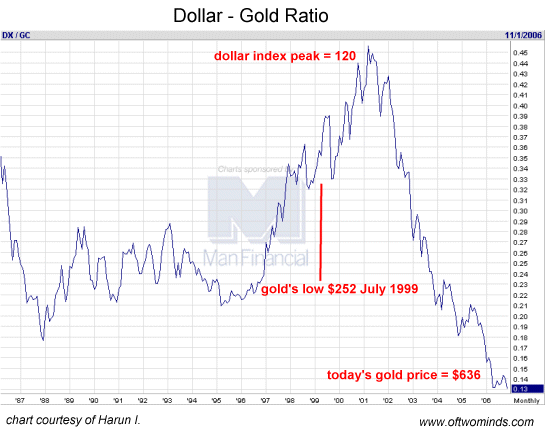
Even taking into consideration the rise (in dollars) of real estate and the stock market, the average American has still not kept pace with either gold or commodities. The rise in net worth priced in dollars has not even offset the decline in wealth priced in real goods and gold. 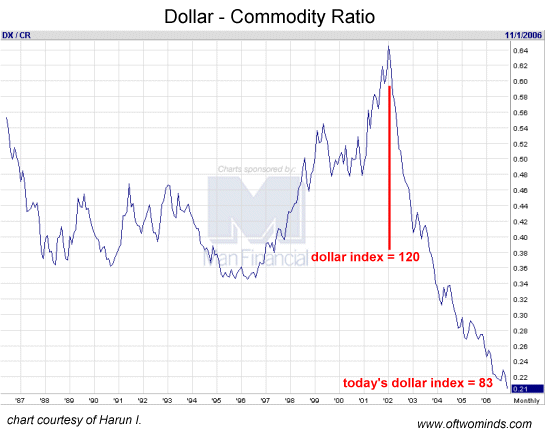
This may help explain why Americans have borrowed hundreds of billions of dollars from their declining home equity just to maintain their lifestyle, and why increasing numbers of Americans feel more financially insecure than they did five year ago. There is little wonder why they feel poorer when you gaze at these charts. They are poorer. Last but not least, let's consider the popular notion that commodity prices are falling. Oh really? Not according to this chart, which reveals that commodities--even with the 25% decline in crude oil prices--are poised to break out to new highs: 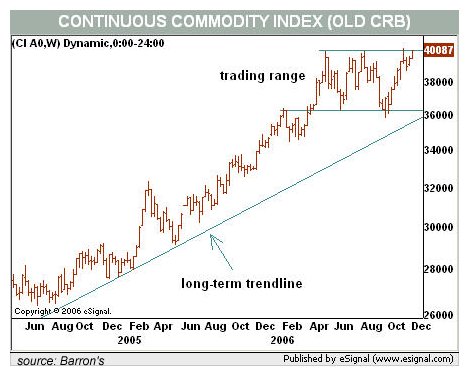
These charts reveal that there is a major divergence between wealth as measured in dollars--what the pundits crow about--and wealth in terms of purchasing power. Americans are far poorer than they were a mere five years ago, before the dollar lost a third of its value and gold and commodities began their ascent. Are you catching on to the deception here? It's similar to the "new Dow high" deception; adjusted for inflation and the declining value of the dollar, the stock market is far from its highs, and Americans have collectively become vastly poorer, even as we borrow billions from foreign investors every day to keep our fabulous deficit lifestyle afloat. Do chickens come home to roost? Yes, they do. And the cheerleader rah-rah Bull Market pundits will rue the day. November 29, 2006 This Week's Theme: Beneath the Surface Part III: The Dow and Gold Frequent contributor Harun I. was kind enough to provide this chart of the Dow Jones Industrial Average (DJI) and the DJI in a ratio with gold (DJI/gold). AT first glance you notice a rather startling disconnect which occurred at the market low in 2002. 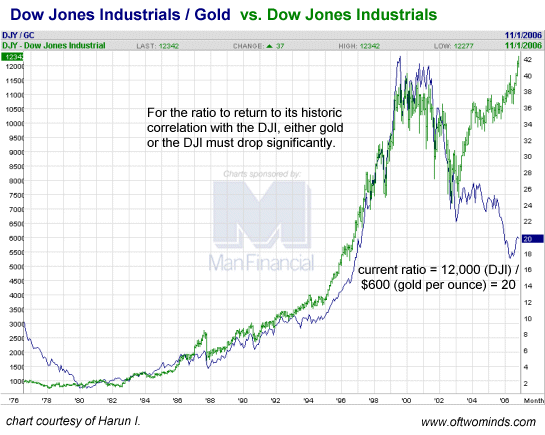
From approximately 1980 through 2002, the ratio of the Dow and gold moved in sync (i.e. was in correlation) with the Dow Jones Industrials. But since the market low in 2002, the two have radically diverged. Now it is always possible that a historic correlation has been broken. But it behooves those of us trying not to lose whatever capital we might have in this world to consider an alternative: that the divergence will return to convergence. One way for this to happen would be for gold to drop in half to $300/ounce. Then the ratio of the DJI to gold would be 40 (12,000 / $300 = 40). Another way would be for the DJI to drop back to the neighborhood of 1,000, where it was in 1980. At that point, the Dow and the price of gold were roughly equal (800 and $800). In the current euphoria of a world awash with liquidity, leveraged assets (derivatives) and a mad scramble for higher yields, such possibilities sound absurd. But just for the sake of argument, what would it take for gold to plummet from $600 to $300? A mighty rise in the dollar, perhaps; and what might trigger such a massive appreciation in the dollar? A complete collapse of the yen and euro, perhaps? But with the U.S. current account deficit already at an unsustainable 7% of GDP, what would cause our trading partners' currencies to collapse and the dollar to double? I am open to the possibility, but the fundamentals behind such a move are unclear. The likelier possibility is a collapse in the dollar and a doubling of the price of gold. Could the Dow fall to 1,000? Various Elliott Wave theorists suggest this is a possibility. What could induce such as drastic collapse of valuation? One mechanism would be high inflation; when Treasuries are paying 15%, stocks are unattractive in the extreme. Another is a collapse in profitability; if a global recession decimated the profits of the DJI companies (for instance, orders for new Boeing jets were cancelled because air traffic had fallen off a cliff, and the need for more Cisco routers vanishes), then on a purely mechanical price-to-earnings basis the Dow could shrink to 1,000. At Bear market lows, the PE ratio sinks to around 8, which is roughly a third of the current Dow PE ratio. In other words, based on a Bear market PE, the Dow could fall to 4,000 with no reduction of actual profit. It's certainly something to ponder. (A.M. addendum: Harun just reminded me of yet another alternative--that the DJI will continue its stratospheric climb. Given the liquidity and euphoria of the past five months, this is entirely possible.) November 28, 2006 This Week's Theme: Beneath the Surface Part II: Bonds and Interest Rates Yesterday we looked at the downtrend in the dollar. Now let's consider the twins: U.S. bonds and interest rates. As long-suffering readers know, I never tire of repeating that the bond market, not the Fed, sets interest and mortgage rates. The consensus which has been propelling the stock market for months is that the Fed will lower Fed Funds Rates, and thereby lower mortgage and interest rates. Nice, but forces are at work which could force the Fed to do the opposite, i.e. raise rates. And why are we considering such an outlandish idea? Take a look at this chart of Treasuries: 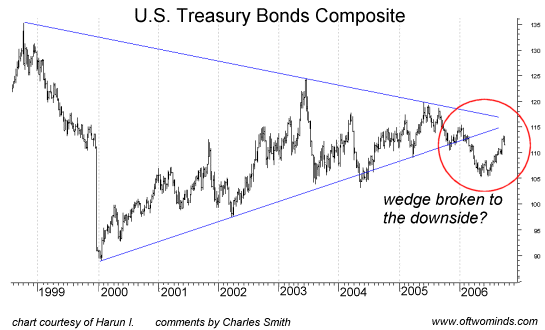
What this chart suggests is a breakdown has occurred--put simply, interest rates aren't dropping, they're set to rise further. What forces could cause such a reversal? Inflation. Again, the consensus is deflationary: the slowing U.S. economy will cause everything to become cheaper. I have attempted to explain here many times that not all forces in the global economy are deflationary. Here is a quick summary: 1. If the dollar drops, imports cost more. That is inflationary. Given that imports are fully 7% of the U.S. GDP, rising import costs are non-trivial. 2. Many costs continue to rise regardless of "deflation:" medical costs, tuition, food, etc. While travel to India for heart surgery is being touted as a solution, it is an extremely small piece of a multi-trillion dollar cost machine. In the meantime, healthcare costs continue climbing. Ditto for tuition, food, water, government services, etc. These essentials are simply costing more on a fundamental basis. Hence my suggestion that deflation is limited to discretionary spending like restaurant meals, while non-discretionary costs such as food, education, healthcare, water and government services are all continuing to rise. 3. Labor costs continue to skyrocket. While outsourcing is continually touted as the deflationary trend which will slay high labor costs, the examples given are trivial in the extreme: yuppies can now hire online tutors based in India for their kids. Nice, but please compare those private savings with the hundreds of billions in local school district budgets, and note the fierce resistance which public unions will offer to "deflationary" proposals such as online tutoring via the Internet. 4. Full employment eventually raises labor costs. In case you haven't noticed, the economy is basically at full employment. Sure, many of the jobs are not great, many are low-paying, and many professionals are under-employed. But to someone who remembers the 15% unemployment of 1981, well, this is as close to full employment as reality can manage. Lest you believe that rising labor costs are mere figments of imagination, please read this recent piece from BusinessWeek: U.S.: Strong Labor Markets Put The Fed On The Spot; Weak productivity and rising labor costs could force more rate hikes. 5. The deflationary benefits of moving production to China have run out. Now the cycle of rising prices from China begins. Please read this feature from last week's BusinessWeek: Secrets, Lies, And Sweatshops. If you read the piece carefully, you'll note that the factories are all forced to cheat on labor laws because the wonderful U.S. retail giants are constantly squeezing the factories for ever-lower prices. This trend of ever-cheaper goods from China is over; labor costs are rising in China, too, as I have documented here previously. As profit margins for Chinese manufacturers drop to 5% and under, there are no more savings to be had. The cost of goods from Cbina will begin to rise. The deflationary wonder days are over. Ask yourself this simple question: what can be made in China that is not already made in China? Autos and aircraft? Undoubtedly, but that is well into the future. In the meantime, virtually everything that can be made in China is made in China. What this means is the deflationary forces of offshoring will diminish. The low-hanging fruit has all been picked, and from here on the benefits of offshoring will be harder to discern and perhaps illusory. 6. The price of oil will not plummet to $20/barrel. Why? Production is falling. As I have documented here repeatedly, the supermassive oil fields which we depend on for the majority of our oil from the Mideast are topping out. The Saudis and Kuwaitis are investing in technologies to wring more oil from these fields, but the easy, cheap stuff is already in decline. A U.S. recession may not depress the price of oil as much as expected. (Please see my "archives" link in the right column for all recent posts on oil/energy.) These forces are non-trivial, long-term and deeply embedded in the economy. Online tutoring is not going to make them all go away. Last but not least, as many others have noted, the Treasury may have to raise its bond yield if foreign buyers of Treasuries become reluctant to add to their $1.5 trillion stash of U.S. Treasuries. If you look at the chart of the dollar (yesterday) and the bond chart (today), both suggest that a defense of the dollar is looming. To defend the dollar, the Treasury must raise the yields. Interest and mortgage rates will also rise. As many have noted, this will pressure the housing market rather severely. Why would the Treasury defend the dollar? As I have noted here repeatedly: because they have no choice. We as a nation are living off the purchases of bonds by foreigners. If they hesitate or falter, the Treasury must raise rates to whatever the market demands. There is no Plan B, and the charts are rather clearly indicating this sobering reality. November 27, 2006 This Week's Theme: Beneath the Surface Part I: The Dollar Like many others who frequent this site, astute reader Jed H. has an interest not just in the bursting housing bubble but in all the moving parts which are intertwined with housing: the stock and bond markets, gold and the dollar. Jed was kind enough to send in links to three comprehensive, well-charted articles from safehaven.com: The Coming Collapse in Housing (11/17/06, by John Mauldin) Is the Dow Forked? (11/26/06, by Gary Tanashian) Death Knell of the US Dollar (11/26/06, by Clive Maund) Jed addressed one immediate topic of interest this way: Are the Dow Industrials & the S&P500 "topping out" from a Bear Rally, OR will this ~ 4 year rise from ~ 2003 go on more until spring 2007 ? Jed H.My own view is that "beneath the surface," the Dow and indeed the S&P 500 and the Nasdaq are all setting up for a very nasty, very sharp and very unexpected decline over the next few weeks. Rather than go directly to an analysis of the Dow (let's save that for later in the week), let's look at the dollar, which fell precipitously last week: 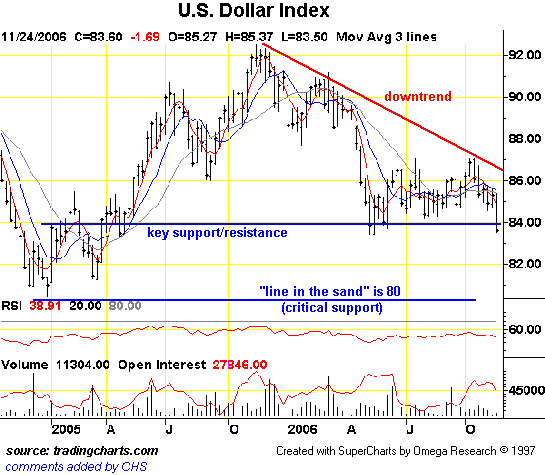
Now maybe the dollar's descent was just a burp caused by light holiday trading, but before you accept that standard-issue complacency, take a look at gold as reflected in the HUI index: 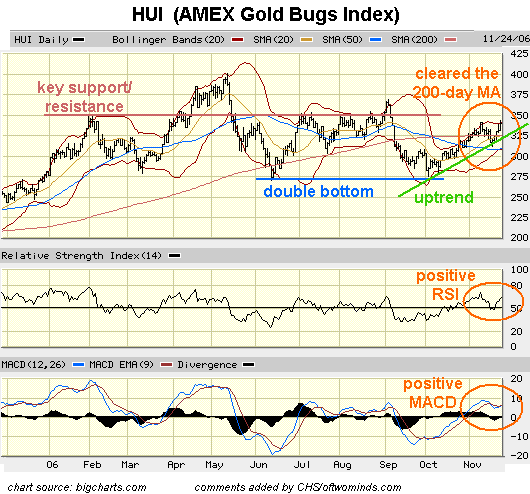
Note the many signs of technical strength in this chart: a successful re-test of lows (the classic double bottom), the rise in price above the 200-day moving average, the uptrend from the October low, and the RSI (relative strength) and MACD indicators in positive territory. It's also interesting that the HUI at 340 is a mere 10 points away from a critical level of support/resistance (350). If the index clears that hurdle then a move to previous highs and beyond would appear to be in the works. While gold and the dollar are not always on a see-saw--when one is up, the other is down--it is rather obvious that the dollar's last peak occurred in early October, just as gold hit its nadir. A vast army of analysts have pointed out that 80 is the key support level for the dollar, going back to the late 70s. There will of course be a defense in depth of that support, for if the dollar breaks decisively through 80, there is no bottom in sight. So what factors are at play in the dollar's decline? The standard line at the moment is that the Eurozone's central bank is poised to raise interest rates, just as the consensus (i.e. sure to be wrong) in the U.S. is solidifying around the idea that the Fed will lower the Fed Funds Rate in a matter of months. But there may be other forces at work beneath the surface--for instance, a divergence between China and the other massive buyers of U.S. debt and dollars. The standard consensus holds that China ($800 billion in dollar reserves), Japan ($700 billion in dollar reserves) and the oil exporting nations of the Gulf (uncounted billions in dollar reserves via London and offshore Caribbean banks) have all been propping up the dollar with stupendous purchases of U.S. Treasury bonds in order to keep the foolish American consumer spending freely on OPEC, Chinese and Japanese exports. While there is an undeniable logic to that, it is also true that a weakening dollar actually benefits China in a way that it does not benefit Euroland, OPEC or Japan. Since the yuan is pegged to the dollar, as the dollar plummets, so too does the yuan, making both American and Chinese exports ever cheaper in Japan and Europe. From China's point of view, what's not to like? Sure, their dollar reserves drop in value, but the name of the game for the Party leadership is jobs--as in creating tens of millions of them to provide incomes to tens of millions of restive peasants fleeing rural poverty. So if their dollar reserves drop in value by $100 billion or so, that is a small price to pay for extending their exports to Europe and Japan--two huge markets with which they currently run trade deficits. Japan, Euroland and OPEC, meanwhile, will be hurt by a plummeting dollar. Since oil is priced in dollars, a 20% drop in the value of the dollar means OPEC receives 20% less value for every barrel of oil they sell in terms of non-U.S. currencies. Japan and Euroland still depend very heavily on exports to the U.S. to prop up their own economies, so a drop in the dollar is most unwelcome, as it immediately raises the cost of their goods to the U.S. consumer. To maintain their market share, they'll have to slash their profit margins--also not a happy thought. You've undoubtedly read how top Chinese bankers keep talking about the risks of holding too many dollars and U.S. bonds. Read between the lines, these cautioning statements are actually akin to loud shouting: "We're not going to support the dollar any longer!!" And why should they? If the dollar drops to 80 or under, then China's exports to Europe and the rest of Asia just got cheaper in those markets. And since the yuan is pegged to the dollar, Chinese goods exported to the U.S. are unaffected by the decline in the dollar. A drop in the dollar can only boost Chinese exports--a very welcome prospect to a nation seeking to create 30-40 million jobs a year. As gold tracks a strongly bullish uptrend, it's something to ponder. Disclosure: I own calls on gold and puts on the DJIA. This is a disclosure, not advice. Note: I may be horribly wrong about everything. I offer no recommendation other than this: do not buy or sell securities based on what others recommend or don't recommend. Do your own analysis and make your own decisions. To view previous entries in November, go to weblog November 2006. Please browse this month's entries and the archived wEssays listed in the sidebar. If nothing here strikes your fancy, skim through my recently published articles (generally in the San Francisco Chronicle) and my archives back to 1995. I would be honored if you link any essay to your website, print a copy for your own use or add my RSS or Atom feed. And of course I appreciate your recommendations of this weblog and your comments: csmith@oftwominds.com. wEssay noun, combination of 'web' and 'essay,' denoting a short online essay which exploits the hyperlinks, interfaces and interactive capabilities of the World Wide Web; coined by Charles Hugh Smith on May 1, 2005, in Berkeley California. Aphorisms I live by: "May a fair road always be open to you." (CHS, April 2, 2006) The way of the Tao is reversal." (Lao Tzu) "Chance favours the prepared mind.” (Louis Pasteur) All content and images copyright © 2006 Charles Hugh Smith, All rights reserved in all media, unless otherwise credited or noted. |
 |
Subscribe via RSS: search my site:
Worth Visiting:
ilind.net Mish's Global Economic Trend Analysis Marin Real Estate Bubble View from Silicon Valley Chris Johnston-futures trader Rick's Picks Gold Eagle Econotech PennyJar Satellite Sky Timothy Brackett's Investment Strategy RV Now-Jim Twamley John Francis Kinsella author/painter Letter from Basque Country buy my novel I-State Lines at The Kaleidoscope (indie bookstore, free shipping) Or from amazon.com: I-State Lines If you want to own gold, I recommend: Buy gold online - quickly, safely and at low prices at BullionVault If you need a quick gift, I recommend: Amazon.com gift certificates Note: at no cost to you, I earn a small commission on purchases made via these two links. |
|
Our retail policy: Nothing is for sale except books/films I recommend and my own novel I-State Lines (via links to Amazon.com and The Kaleidoscope: Our Focus Is You independent bookstore) Free alternative: find them at your local library. Though I earn a small commission on Amazon.com books and gift certificates and gold (BullionVault) purchased via links on my site, I receive no advertising fees for any links, ads or materials on my site. |
home |